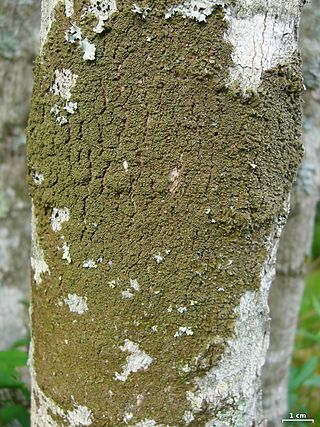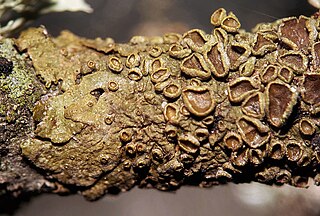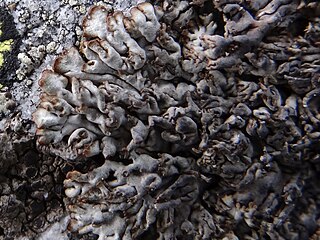
The Parmeliaceae is a large and diverse family of Lecanoromycetes. With over 2700 species in 71 genera, it is the largest family of lichen-forming fungi. The most speciose genera in the family are the well-known groups: Xanthoparmelia, Usnea, Parmotrema, and Hypotrachyna.

Pseudephebe is a genus of fruticose lichens in the family Parmeliaceae. It contains three species that grow on rocks.

Arctocetraria is a genus of foliose lichens in the family Parmeliaceae. It has three species.

Cetrariella is a genus of foliose lichens in the family Parmeliaceae. It contains three species.

Kaernefeltia is a genus of lichenized fungi in the family Parmeliaceae.

Melanelia is a genus of lichenized fungi in the family Parmeliaceae. The genus was circumscribed by Ted Esslinger in 1978.

Melanohalea is a genus of foliose lichens in the family Parmeliaceae. It contains 30 mostly Northern Hemisphere species that grow on bark or on wood. The genus is characterized by the presence of pseudocyphellae, usually on warts or on the tips of isidia, a non-pored epicortex and a medulla containing depsidones or lacking secondary compounds. Melanohalea was circumscribed in 2004 as a segregate of the morphologically similar genus Melanelia.

Melanelixia is a genus of foliose lichens in the family Parmeliaceae. It contains 15 Northern Hemisphere species that grow on bark or on wood. The genus is characterized by a pored or fenestrate epicortex, and the production of lecanoric acid as the primary chemical constituent of the medulla. Melanelixia was circumscribed in 2004 as a segregate of the related genus Melanelia.
Cetrariopsis is a genus of foliose lichens in the large family Parmeliaceae. The genus contains three species, including the type, Cetrariopsis wallichiana.

Tuckermanella is a genus of lichen-forming fungi in the family Parmeliaceae.

Notoparmelia is a genus of foliose lichens in the family Parmeliaceae. It includes 18 species that grow on bark and rocks, and are mostly distributed in the Southern Hemisphere. The genus was created in 2014 as a segregate of Parmelia.
Melanohalea zopheroa is a species of lichen in the family Parmeliaceae. It was first formally described in 1977 by Ted Esslinger as Parmelia zopheroa. A year later, he transferred it to the new genus Melanelia, which he created to contain the brown Parmeliae species. In 2004, after early molecular phylogenetic evidence showed that Melanelia was not monophyletic, Melanohalea was circumscribed by lichenologists Oscar Blanco, Ana Crespo, Pradeep K. Divakar, Esslinger, David L. Hawksworth and H. Thorsten Lumbsch, and M. zopheroa was transferred to it. The lichen has a disjunct distribution, as it is found in South America (Chile) and in New Zealand.
Melanohalea ushuaiensis is a species of lichen in the family Parmeliaceae. It was first formally described in 1917 by Alexander Zahlbruckner as Parmelia ushuaiensis. Ted Esslinger transferred to the new genus Melanelia in 1978, which he circumscribed to contain the brown parmeliae species. In 2004, it was moved to the newly created genus Melanohalea. It is endemic to South America.
Melanohalea trabeculata is a species of foliose lichen in the family Parmeliaceae. It was first formally described by Finnish lichenologist Teuvo Ahti in 1966 as Parmelia trabeculata. Ted Esslinger transferred the species to the new genus Melanelia in 1978, which he circumscribed to contain the brown parmeliae species. In 2004, it was moved to the newly circumscribed genus Melanohalea.
Melanohalea subverruculifera is a species of lichen in the family Parmeliaceae. Found in China, it was first formally described as a new species in 1980 as Parmelia subverruculifera. It was transferred to the segregate genus Melanelia in 1991, and then to the genus Melanohalea in 2004.

Melanohalea subolivacea, commonly known as the brown-eyed camouflage lichen, is a species of foliose lichen in the family Parmeliaceae.

Melanohalea subelegantula is a species of lichen in the family Parmeliaceae. It is found in North America, where it grows on bark and wood. The lichen was first formally described as Parmelia subelegantula by Ted Esslinger in 1977. A year later he transferred it to the segregate genus Melanelia. In 2004, it was moved to the newly circumscribed genus Melanohalea. Named for its resemblance to Melanohalea elegantula, it can be distinguished from that species by its slightly flattened, but not hollow, isidia.

Melanohalea elegantula, commonly known as the elegant camouflage lichen, is a species of lichen in the family Parmeliaceae. It was first described by Alexander Zahlbruckner in 1894 as Parmelia aspidota var. elegantula. Hungarian lichenologist Ödön Szatala promoted it to full species status, as Parmelia elegantula, in 1930. Ted Esslinger transferred it to the genus Melanelia in 1978. Finally, it was assigned to the newly circumscribed genus Melanohalea in 2004.

Montanelia is a genus of lichenized fungi belonging to the family Parmeliaceae. It was circumscribed by Pradeep K. Divakar, Ana Crespo, Mats Wedin, and Theodore L. Esslinger in 2012 to accommodate a group of five species previously assigned to the genus Melanelia.
Allocetraria corrugata is a species of foliose lichen in the family Parmeliaceae. It is found in high-elevation locations in Yunnan, China, where it grows on rocks with mosses.













